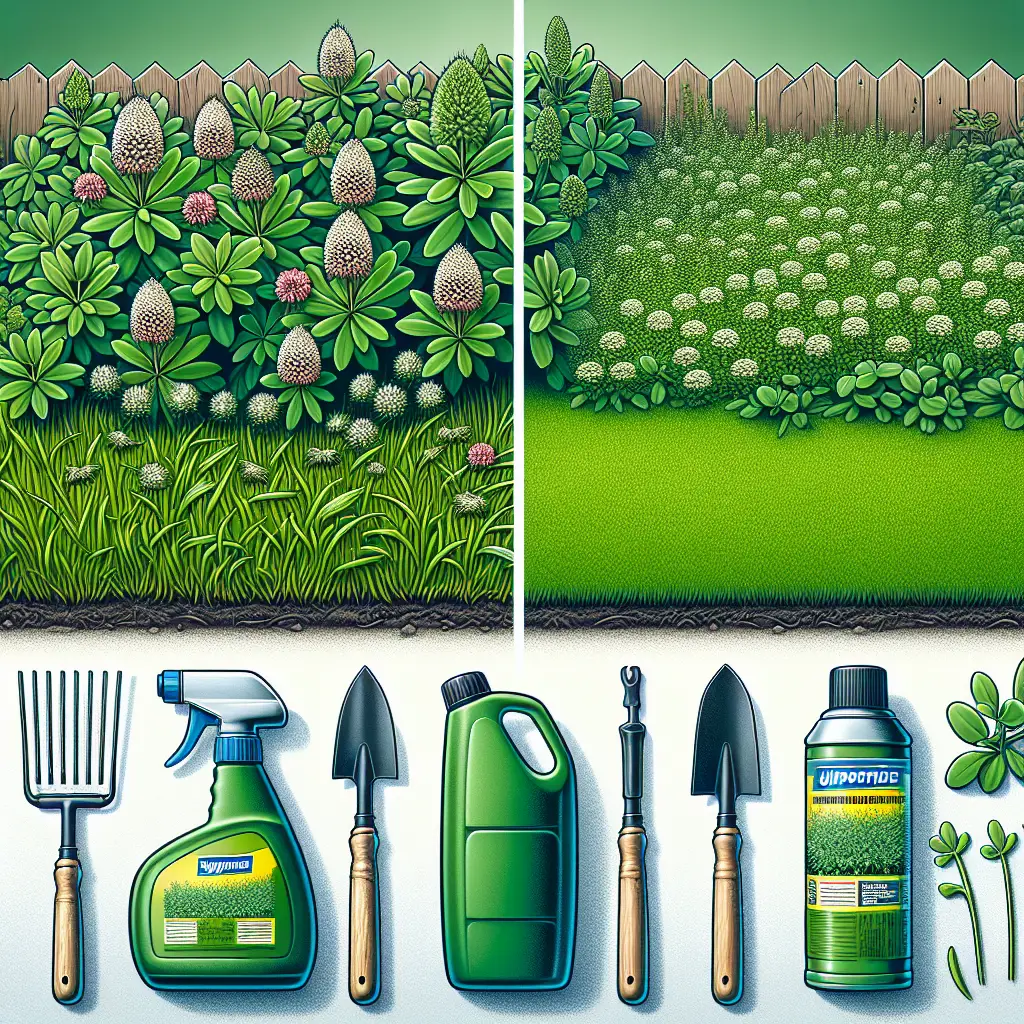How to Identify and Control Spurge in Your Lawn
Updated July 13, 2024 at 5:18 am

Understanding Spurge in Your Lawn
- Pet Friendly: Spurge can be toxic if ingested by pets. Proper identification and control are important to keep your furry friends safe.
- Light Requirements: Spurge typically thrives in sunny areas but can also survive in partial shade, often complicating efforts to eliminate it completely.
- Watering: While spurge can withstand dry conditions, it often emerges in lawns with inconsistent watering practices.
- Humidity: This plant can adapt to various humidity levels, which assists in its spread across many different regions.
- Temperature: Spurge is a warm-season weed, actively growing during the hot summer months.
- Difficulty: While persistent, with the right approach, you can control and eradicate spurge from your lawn effectively.
Have you noticed a low-growing, mat-forming weed with small leaves taking over patches of your lawn? Chances are you might be dealing with a common invader known as spurge. This weed is not only unsightly but it can be quite stubborn to get rid of once it has established itself.
Spurge, particularly the variety known as “prostrate spurge”, can be identified by its sprawling growth pattern, smooth oval-shaped leaves, and stem that exudes a milky sap when broken. This trait is a telltale sign, along with the tiny, inconspicuous flowers it bears. Eradicating spurge requires a measured approach, tackling both prevention and control.
Prevention and Early Detection
Before delving into products and methods for eliminating spurge, let’s talk about prevention. A healthy lawn is your first defense against this aggressive weed. Dense, well-maintained turfgrass can significantly reduce the chances of spurge taking hold. That means regular mowing at the right height for your grass type, proper fertilization, and consistent watering practices to encourage thick lawn growth that leaves little room for spurge to emerge.
Early detection is equally crucial. Regularly inspect your lawn for the early stages of weed growth. Spurge tends to germinate in the heat of summer, so vigilance during this season is key. Catching it early means you can avoid a full-blown infestation and the need for more aggressive treatments down the line.
Manual Control Measures
For those smaller patches of spurge in your lawn, manual removal is a viable option, especially if you catch it early. Pulling spurge out by hand can be effective; however, you must ensure you remove the entire root system to prevent the plant from regrowing. This method is most successful after a rain when the soil is moist, and roots are more pliable.
Wearing gardening gloves is recommended, as the milky sap can be an irritant to skin and is potentially harmful if in contact with your eyes or if ingested by household pets. Careful disposal of uprooted spurge is essential to avoid spreading the seeds to other areas of your garden or lawn.
Chemical Control Options
If your lawn has a widespread spurge problem, manual removal might not be practical, and this is where herbicides come into play. Pre-emergent herbicides can prevent spurge seeds from germinating, while post-emergent herbicides address spurge that has already grown. Products containing active ingredients like dicamba, 2,4-D, or quinclorac can be effective against spurge.
As with any chemical, it’s important to follow the label instructions carefully. Misapplication can damage your lawn and harm beneficial insects, pets, and even your own health. Applying herbicides during calm, dry weather ensures minimal impact on the surrounding environment and maximizes effectiveness against spurge.
Choosing the Right Herbicide
Let’s explore a well-reviewed herbicide option for controlling spurge: Spectracide Weed Stop For Lawns Plus Crabgrass Preventer. This product combines the action of a pre-emergent and a post-emergent herbicide, offering a comprehensive solution. Many users praise its effectiveness in not only preventing new weeds from sprouting but also killing existing ones like spurge.
The granular formulation of Spectracide Weed Stop makes for easy application with a spreader, and it’s designed to work when watered in after spreading. It is vital, however, to use it at the right times of the year – early spring and fall – for optimal results. Now, let’s evaluate what people are saying and give you a balanced take on this product:
Pros
- Effective dual-action – prevents new weeds and kills existing ones.
- User-friendly with easy application instructions.
- Granular formula allows for even distribution with a standard lawn spreader.
- Works on a variety of weeds including spurge and crabgrass.
Cons
- Chemical herbicides can have environmental impacts and may be unsuitable for eco-conscious gardeners.
- Not recommended for use on all turfgrass types, so check compatibility with your lawn.
- Requires careful handling and diligent follow-up applications for lasting results.
Find This and More on Amazon
Organic and Natural Alternatives
For those who prefer a more natural approach, there are several organic alternatives to controlling spurge. Corn gluten meal is a natural pre-emergent herbicide that can inhibit seed germination without the use of harsh chemicals. It needs to be applied early in the season before the spurge seeds have a chance to sprout.
Vinegar-based solutions can also be an effective post-emergent treatment for spurge. Acetic acid in household vinegar can dessicate the leaves of young spurge plants. However, repeated applications may be necessary, and you should exercise caution to avoid harming desirable plants.
Cultivating a Spurge-Resistant Lawn
A key aspect of spurge control is adapting your lawn care routine to create an environment that’s less hospitable to weed growth. Regular aeration can improve soil health, allowing your grass to grow thicker and outcompete weeds like spurge. Selecting a grass type suited to your region’s climate and maintaining it diligently can make a world of difference.
Proper watering and fertilization are equally important. Overwatering can lead to shallow root systems and weaker grass, which can create opportunities for spurge to encroach. Strike a balance between keeping your lawn healthy and avoiding conditions that favor weed growth.
When to Call in the Professionals
Sometimes, despite our best efforts, spurge can still gain the upper hand. If you’re dealing with a severe infestation or lawn conditions that make it difficult to control on your own, it might be time to call in a professional lawn care service. They can offer tailored solutions and have access to professional-grade products that may not be available to the general public.
When selecting a service, look for those that have good reviews and a track record of success in weed control. They will assess your specific situation and provide a customized treatment plan. This may include a combination of cultural practices, chemical treatments, and even lawn renovation if necessary.
Maintaining Your Lawn Post-Spurge
Once you’ve succeeded in controlling spurge, the work isn’t over. To prevent future infestations, you must continue with a proactive lawn maintenance schedule. Monitor your lawn’s health, patch any bare spots quickly to prevent weeds from gaining a foothold, and adapt your watering and fertilizing regime to the needs of your turfgrass.
Remember, maintaining a spurge-free lawn is an ongoing process. It encompasses diligent observation, timely intervention, and sustainable practices that support the overall health of your lawn. Keeping up with these tasks will not only help you control spurge but also enhance the beauty and vitality of your lawn as a whole.
Final Thoughts on Spurge Control
Controlling spurge in your lawn requires a multifaceted approach, balancing preventative measures, timely interventions, and proper lawn care techniques. Whether you opt for manual removal, chemical treatments, or organic alternatives, staying informed and vigilant is key to keeping your lawn spurge-free.
Remember, at the heart of it all is a desire for a beautiful, healthy lawn. The effort you invest in combating spurge and other lawn weeds will pay off with a lush, green space that you can enjoy all year round. Stay patient, stay persistent, and don’t hesitate to reach out for professional help if the challenge seems too great to handle alone. Happy gardening!
Integrating Cultural Methods for Spurge Prevention
In addition to the direct control measures discussed, incorporating cultural practices into your lawn care routine can significantly aid in spurge prevention. Cultivating a dense and vigorous turfgrass is arguably the best defense against this invasive weed.
Selecting the correct grass type for your climate and soil is fundamental for healthy growth. For example, if you’re in a cooler region, fescue or bluegrass varieties may be more appropriate, while warmer regions may benefit from Bermuda or zoysia grass. The right choice of grass ensures a thick lawn that can outcompete spurge naturally.
The Importance of Lawn Mowing and Maintenance
Regular lawn mowing is more than just an aesthetic practice; it plays a vital role in spurge control. Mowing at the correct height for your specific grass type encourages stronger root systems and a denser lawn, which leaves less space for spurge to establish. Avoid cutting your grass too short, as scalping the lawn can stress the grass and reduce its ability to compete against weeds.
Regular inspections can also identify issues such as thatch build-up, which can be a haven for spurge seeds. Dethatching your lawn promotes better water and nutrient penetration, again reinforcing the health of your grass and reducing opportunities for spurge to emerge.
Natural Herbicide: How to Use Vinegar Safely
As some homeowners look for natural herbicide options, vinegar has gained popularity for its weed-control properties. To use vinegar safely and effectively on spurge, consider a higher concentration vinegar designed for horticultural use. Standard household vinegar may not be potent enough to completely kill established weeds, while stronger formulas offer better results.
When applying vinegar, target the application directly onto the spurge, being careful to limit contact with surrounding grass or plants, as vinegar is a non-selective herbicide and can harm desirable vegetation. The best time to apply vinegar is during dry, sunny weather to maximize the dessicating effect on the spurge plants.
Soil Health and Spurge Suppression
A healthy lawn starts from the ground up, so paying attention to your soil health is crucial for spurge suppression. Having your soil tested for pH and nutrient content can provide valuable information for tailoring your fertilization and maintenance strategy. Spurge can often thrive in compacted or poor-quality soil, so amendments may be necessary.
Utilizing organic matter can improve soil structure and fertility over time. Composted manure, peat moss, or compost can all serve to add valuable nutrients to the soil. These amendments encourage robust turfgrass growth, thereby reducing spurge’s ability to infiltrate.
Lawn Aeration for Enhanced Grass Health
Core aeration is another technique that can significantly contribute to controlling spurge. By removing small cores of soil and thatch from the lawn, aeration allows air, water, and nutrients to penetrate more deeply into the soil. As a result, your grass will develop deeper roots and become more stress-tolerant, which can discourage spurge proliferation.
For best results, aerate your lawn during its peak growing season when the grass can recover quickly. For cool-season grasses, this is typically the fall, while for warm-season grasses, late spring to early summer is ideal. Ensuring that the aeration is done effectively and at the right time can help your lawn stay thick and resistant to spurge and other weeds.
Recap on the Identification of Spurge
When it comes to identifying spurge in your lawn, remember to look for those distinctive features. The small leaves and mat-forming growth habit, coupled with the milky sap when the stem is snapped, are key indicators. Catching it early is your best bet for simpler, less intensive management.
Always be on the lookout for new patches of spurge, especially after periods of high temperatures or disturbance to your lawn. Swift identification leads to timely actions, whether that be manual removal or the application of a suitable herbicide or natural remedy.
Exploring the Different Types of Spurge
It’s worth noting that there are multiple types of spurge you may encounter. Prostrate spurge is commonly found in lawns, but there are also spotted spurge, creeping spurge, and others that may present themselves. Each type may require slightly different approaches for control based on their growth patterns and resilience.
Being able to differentiate between these species is helpful. For example, spotted spurge tends to have darker spots on the leaves, which can aid in its identification. Paying attention to these differences can assist you in choosing the most effective control method for the specific type of spurge you’re dealing with.
Long-Term Management and Monitoring
Lastly, it’s important to understand that controlling spurge is an ongoing battle. Even if you have successfully cleared your lawn of spurge, continue to monitor for any signs of its return. Adjust your lawn care practices as needed, and don’t neglect those cultural methods that keep your lawn vigorous and competitive against weed invasions.
Stay diligent with your weed control measures, whether you’re using pre-emergent herbicides each season, maintaining a strict mowing schedule, or employing natural weed control methods. By keeping up with these tasks, you maintain the upper hand against spurge and ensure that your lawn remains a place of beauty and enjoyment.
Tailored Lawn Care: Adapting to Seasonal Changes
Adapting your lawn care to the changing seasons is crucial for spurge control. As the seasons shift, so do the needs of your lawn. In spring, focus on pre-emergent herbicide application to prevent spurge germination and bolster grass growth with timely fertilization.
In summer, watch for spurge outbreaks, particularly during periods of drought or heat, when your lawn might be stressed. The fall is an optimal time for overseeding, aeration, and applying another round of pre-emergent if needed, to ensure your lawn is healthy and robust as it enters the dormant winter period.
Avoiding Common Mistakes in Spurge Management
One of the common mistakes in weed management is the improper application of herbicides, which can lead to ineffective control and could even damage your lawn. Always calibrate your sprayer or spreader correctly and apply herbicides at the recommended rates. Overuse of chemicals can cause more harm than good, potentially contaminating nearby water sources and harming wildlife.
Another mistake is neglecting the rest of your lawn care routine. Spurge control is not just about what you apply but how well you maintain your lawn’s overall health. Never forget the basics: proper mowing, fertilizing, watering, and aeration are all essential elements of an integrated spurge management strategy.
Embracing Eco-Friendly Lawn Care Practices
Eco-friendly lawn care is becoming increasingly important, and it can certainly coexist with spurge management. Using native grasses that are well-adapted to your climate and soil conditions can reduce the need for water, fertilizers, and herbicides. Creating a biodiverse lawn, with a mix of grasses and other plants, can also foster an ecosystem that naturally keeps weeds like spurge at bay.
Consider reducing your lawn size too. Expanding garden beds with mulch or native plants can provide a buffer zone that reduces weed incursion. By embracing eco-friendly practices, you’re not only working towards a spurge-free lawn but also contributing to a healthier, more sustainable environment.
Monitoring New Products and Industry Advancements
Lastly, keeping an eye on new industry advancements and product releases is a good practice for long-term spurge control. Lawn care and weed management technologies are continuously evolving, with new herbicides and organic solutions being developed that might be more effective or environmentally friendly than current options.
Professional lawn care services and extension offices can be valuable resources. They often have the latest information on the best practices and products for controlling lawn weeds like spurge. Staying informed can give you an edge in maintaining a lush, spurge-free lawn.
Wrapping Up Our Guide to Spurge Control
Your commitment to understanding and managing spurge in your lawn can make all the difference between a weed-infested yard and a pristine green oasis. By integrating the various strategies discussed—from preventive measures, manual and chemical control, natural alternatives, to a strong focus on overall lawn health—you’re now well-equipped to tackle this pervasive weed.
With patience and persistence, you can keep spurge and other weeds from taking over your space. Remember, an ounce of prevention is worth a pound of cure, especially in lawn care. Keep up the excellent work, stay vigilant, and enjoy the fruits of your labor—a beautiful, healthy lawn that enhances your home and brings joy to your outdoor activities.
Shop more on Amazon

